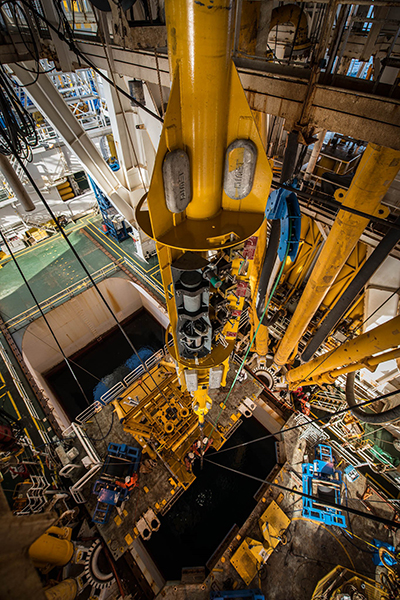
South of the Japanese coast and thousands of meters underwater lies the Nankai Trough, the site of a subduction zone that produces huge earthquakes every 100–150 years. As the Philippine Sea plate dips beneath the Eurasian plate, sediment scrapes off and accretes in the trough. New research by Kinoshita and Saffer reveals that at large scales, this accretionary wedge is highly permeable to fluid flow.
 A view of the borehole observatory head, with pressure sensors and valves attached, being lowered into the ocean. Its ultimate destination was more than 2,000 meters below sea level. Credit: Dick Peterse, ScienceMedia.nl
A view of the borehole observatory head, with pressure sensors and valves attached, being lowered into the ocean. Its ultimate destination was more than 2,000 meters below sea level. Credit: Dick Peterse, ScienceMedia.nl
Rock permeability affects many processes and systems, including groundwater transport, oil production, and thermal vent ecosystems. In subduction zones, water flowing through rock can influence seismic activity. However, most investigations of subduction zone permeability have relied on drill core samples and have been conducted at small scales—as small as 1 centimeter. This means that data are lacking for scales of tens to hundreds of meters.
Recently, the Nankai Trough Seismogenic Zone Experiment (NanTroSEIZE) provided a unique opportunity to investigate large-scale permeability of the Nankai accretionary wedge. As part of this project, scientists are drilling deep into the trough to collect samples and install sensors to illuminate earthquake- and tsunami-triggering processes in the area.
After installing pressure-sensing equipment in one of their completed boreholes, NanTroSEIZE scientists began to drill two more boreholes about 100 meters away. The authors harnessed this opportunity to measure the impact of distant drilling on fluid pressure at the completed borehole. They analyzed the pressure data using a two-dimensional mathematical model, which enabled them to calculate the permeability of rock spanning the distance between the old and new boreholes.
Their analysis yielded a permeability value 2–4 orders of magnitude higher than seen in previous small-scale experiments, including previous analyses led by the authors. Considering these earlier findings, it is apparent that permeability measurements in the Nankai wedge increase at larger scales, probably because big fractures and faults that contribute significantly to permeability can be captured only at larger scales.
In other parts of the world, similar analyses of seismically inactive submarine zones have revealed more uniform permeability across different scales. This is in harmony with the hypothesis that the scale dependence seen in the Nankai Trough is due to fractures and faulting. (Geophysical Research Letters, https://doi.org/10.1029/2018GL078304, 2018)
—Sarah Stanley, Freelance Writer
The post In a Submarine Trough, Permeable Rocks May Lead to Quakes appeared first on Eos.
from Eos https://eos.org/research-spotlights/in-a-submarine-trough-permeable-rocks-may-lead-to-quakes?utm_source=rss&utm_medium=rss&utm_content=in-a-submarine-trough-permeable-rocks-may-lead-to-quakes
via IFTTT

